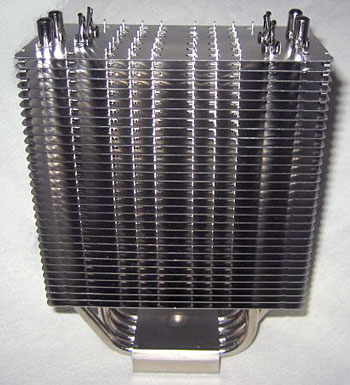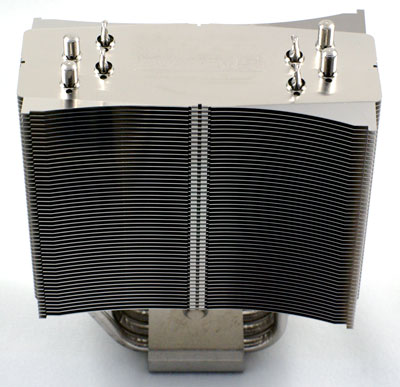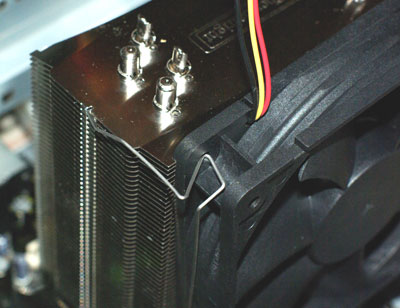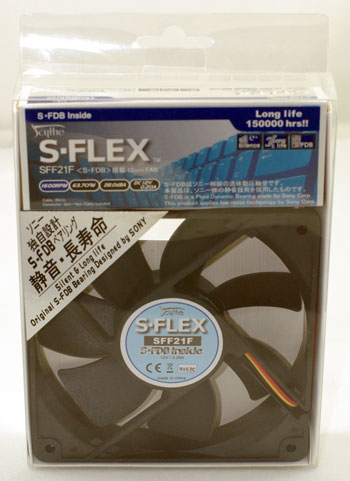Thermalright Ultra 120: Elegant, Fanless and Efficient Cooling
by Wesley Fink on March 5, 2007 12:05 AM EST- Posted in
- Cases/Cooling/PSUs
Readers who tenaciously seek silence in their PC will probably recognize the Thermalright Ultra 120. It is not exactly the same heatsink, but it is similar in appearance to the HR-01 fanless cooler introduced by Thermalright in late 2005. That cooler shipped for AMD only, as we were still in the hot Intel Prescott days. Adapters were introduced later to allow HR-01 to mount on newer sockets, and HR-01 is still in the Thermalright product line as a fanless cooler.

However, there is no way to even mount a fan on the early versions of HR-01, so its appeal was limited to users seeking silence at around stock speeds. Overclockers really had little use for the HR-01. Thermalright recognized that a cooler designed to perform well with no fan could be very attractive to overclockers if there were some means of active cooling, and so the Ultra 120 was born.

The Thermalright Ultra 120 refines the shape of the HR-01 and adds the ability to mount a 120mm fan to the heatsink tower. If you look closely you can see that the cooling fin edges are turned up on one end and turned down at the other end of the same fin. This creates airflow patterns that are refined in subtle ways from the more common flat fins. Unlike the HR-01 the Ultra 120 is designed to operate with a 120mm fan. The heritage, however, is the fanless HR-01 design, and we will also evaluate the Thermalright Ultra 120 as a fanless design.
Since no fan comes in the Ultra 120 kit the buyer is free to select the fan that best serves their needs. This is something of a "gotcha" in the Ultra 120 design because the fan wires are designed to clip into the lower holes on a 120mm fan post.

The problem with this design is that fans with a full post, which are most of the fans available in the lab, will not mount on the Ultra 120. You have to use a fan with holes instead of a full post. Fortunately two of the better fans that are available, the Noctua and the Scythe S-Flex, both use the 4-hole design.
There are also some advantages to the fan clip design. Since the wire clips on the bottom of the fan you can use a 120mm fan of any thickness; You are not limited to 25mm. That is if you can find the fan in a postless design.
The Noctua fans are an excellent choice for a silent PC. One of the available Noctua fans even has a noise rating of 8dB-A. Since our goal was maximum overclocking along with reasonable quiet the Scythe S-Flex was chosen in the highest RPM version that was available. This was the 1600rpm, 63.7 CFM SFF21F. The S-Flex uses the Sony Fluid Dynamic Bearing design for the fan motor instead of ball bearings or sleeve bearings.

The Sony FDB should translate into a quiet fan, even at higher speeds, and it has a very long fan life. Scythe specifies the fan life as an incredible 150,000 hours. Even with the high CFM rating the Scythe SFF21F is still rated at a quiet 28dB-A, which is well below the noise floor of our test system's power supply. The Thermalright Ultra 120 and Scythe S-Flex SFF21F were both provided for review by Frozen CPU. This means both items are straight off the retail shelf.
The advantage of using after market fans is you can choose the fan based on your system goals - silence, overclocking, or a combination of both. The disadvantage, of course, is that you need to buy a fan to go with your heatsink, where complete kit designs have a fan that is matched by the manufacturer to the heatsink. Both approaches can be argued, but the fan is a cost in addition to the heatsink cost. 120mm fans can cost as little as $3, but the S-Flex was about $15 and the Noctua fans sell for as much as $25.
With the Thermalright Ultra 120 and Scythe S-Flex combo there are several questions to be answered in our tests. Does the Ultra 120 live up to its billing by many users as the best heatsink you can buy? How does the Ultra 120 compare in overclocking abilities to the best heatsink towers tested at AnandTech? Since it is based on a fanless design, can the Ultra 120 be used as a fanless and zero noise CPU cooler?

However, there is no way to even mount a fan on the early versions of HR-01, so its appeal was limited to users seeking silence at around stock speeds. Overclockers really had little use for the HR-01. Thermalright recognized that a cooler designed to perform well with no fan could be very attractive to overclockers if there were some means of active cooling, and so the Ultra 120 was born.

The Thermalright Ultra 120 refines the shape of the HR-01 and adds the ability to mount a 120mm fan to the heatsink tower. If you look closely you can see that the cooling fin edges are turned up on one end and turned down at the other end of the same fin. This creates airflow patterns that are refined in subtle ways from the more common flat fins. Unlike the HR-01 the Ultra 120 is designed to operate with a 120mm fan. The heritage, however, is the fanless HR-01 design, and we will also evaluate the Thermalright Ultra 120 as a fanless design.
Since no fan comes in the Ultra 120 kit the buyer is free to select the fan that best serves their needs. This is something of a "gotcha" in the Ultra 120 design because the fan wires are designed to clip into the lower holes on a 120mm fan post.

The problem with this design is that fans with a full post, which are most of the fans available in the lab, will not mount on the Ultra 120. You have to use a fan with holes instead of a full post. Fortunately two of the better fans that are available, the Noctua and the Scythe S-Flex, both use the 4-hole design.
There are also some advantages to the fan clip design. Since the wire clips on the bottom of the fan you can use a 120mm fan of any thickness; You are not limited to 25mm. That is if you can find the fan in a postless design.
The Noctua fans are an excellent choice for a silent PC. One of the available Noctua fans even has a noise rating of 8dB-A. Since our goal was maximum overclocking along with reasonable quiet the Scythe S-Flex was chosen in the highest RPM version that was available. This was the 1600rpm, 63.7 CFM SFF21F. The S-Flex uses the Sony Fluid Dynamic Bearing design for the fan motor instead of ball bearings or sleeve bearings.

The Sony FDB should translate into a quiet fan, even at higher speeds, and it has a very long fan life. Scythe specifies the fan life as an incredible 150,000 hours. Even with the high CFM rating the Scythe SFF21F is still rated at a quiet 28dB-A, which is well below the noise floor of our test system's power supply. The Thermalright Ultra 120 and Scythe S-Flex SFF21F were both provided for review by Frozen CPU. This means both items are straight off the retail shelf.
The advantage of using after market fans is you can choose the fan based on your system goals - silence, overclocking, or a combination of both. The disadvantage, of course, is that you need to buy a fan to go with your heatsink, where complete kit designs have a fan that is matched by the manufacturer to the heatsink. Both approaches can be argued, but the fan is a cost in addition to the heatsink cost. 120mm fans can cost as little as $3, but the S-Flex was about $15 and the Noctua fans sell for as much as $25.
With the Thermalright Ultra 120 and Scythe S-Flex combo there are several questions to be answered in our tests. Does the Ultra 120 live up to its billing by many users as the best heatsink you can buy? How does the Ultra 120 compare in overclocking abilities to the best heatsink towers tested at AnandTech? Since it is based on a fanless design, can the Ultra 120 be used as a fanless and zero noise CPU cooler?










30 Comments
View All Comments
Wesley Fink - Monday, March 5, 2007 - link
I have changed the comment to "remove" air.A quick glimpse at www.newegg.com shows a number of power supplies with down-facing fans. Examples are the the OCZ GameXStream 700 at http://www.newegg.com/Product/Product.asp?Item=N82...">http://www.newegg.com/Product/Product.asp?Item=N82..., the Seasonic at http://www.newegg.com/Product/Product.asp?Item=N82...">http://www.newegg.com/Product/Product.asp?Item=N82..., the Coolermaster 550W http://www.newegg.com/Product/Product.asp?Item=N82...">http://www.newegg.com/Product/Product.asp?Item=N82..., the Thermaltake 550w at http://www.newegg.com/Product/Product.asp?Item=N82...">http://www.newegg.com/Product/Product.asp?Item=N82..., the Raidmax at http://www.newegg.com/Product/Product.asp?Item=N82...">http://www.newegg.com/Product/Product.asp?Item=N82..., and the Enermax at http://www.newegg.com/Product/Product.asp?Item=N82...">http://www.newegg.com/Product/Product.asp?Item=N82....
Even at the low end you can find down-facing fans such as the Xion 500W, $29.95 after rebate at http://www.newegg.com/Product/Product.asp?Item=N82...">http://www.newegg.com/Product/Product.asp?Item=N82..., the house brand Rosewell 400w at http://www.newegg.com/Product/Product.asp?Item=N82...">http://www.newegg.com/Product/Product.asp?Item=N82..., and the Sparkle 350W at http://www.newegg.com/Product/Product.asp?Item=N82...">http://www.newegg.com/Product/Product.asp?Item=N82....
Fans which remove air from the CPU area are VERY common and not difficult to find.
johnsonx - Tuesday, March 6, 2007 - link
I think you misunderstood the gist of my comment, but your correction to the article is indeed correct. I was making the point that the bottom fan of a power supply does not BLOW air onto the CPU area, rather it intakes air FROM that area. I'm well aware there are numerous such power supplies available (personally I prefer the ones that have both a bottom and a rear fan, but there are valid points both ways on that debate).Sometimes I try to be too creative in my phrasing, thus obfuscating my central point beyond recognition.
nilepez - Monday, March 5, 2007 - link
Since you're reviewing HS, perhaps you need to test them all with the same fan (assuming they take the same fan size). Obviously some come with fans, and you'd want to test with the stock fan, but to make things equal, I think you need to pick a fan (Skythe, Noctua, Panaflo et al.) and test them all with that fan as well. Only then will we know what the best HS is.My guess is that Thermalright would still be up there, as they're generally one of the best HS makers (if not the best) out there.
Rocket321 - Monday, March 5, 2007 - link
I would love to see a review of the Ultra 90 you mentioned on page 2. I'm hoping to find something a little lighter than these highend coolers without moving into the budget sector.ADDAvenger - Monday, March 5, 2007 - link
I'd be interested in a review of that as wellorion23 - Monday, March 5, 2007 - link
Thank you guys for another great review! Great Job!It's nice that these coolers are being tested with new setups (C2D) unlike many other sites that choose to test with "old hardware".
I've always been a fan of the Thermalright Ultra 120 which BTW has kept my 4ghz overclock (E6600) idling @ 28-35 and 50c under load. I tried a Tuniq Tower but the results were @ least 5c higher with the Tuniq!
Go Thermalright!
jonman03 - Tuesday, March 6, 2007 - link
I have to agree, we get alot of requests for these on our custom systems. Great cooler, looks great in windowed cases. What else could you ask for?http://www.plugcomputers.com">Custom Gaming Computers - Plug Computers
1111111 - Monday, March 5, 2007 - link
A few minutes with a hacksaw works fine to remove a section of the fan posts. That's what I ended up doing with my Thermalright Ultra-120/Yate Loon D12SL-12.
Wesley Fink - Monday, March 5, 2007 - link
Your suggestion works, and the hack saw works best if you have a vise to hold the fan while you saw. A jigsaw melts the plastic as it moves too fast and creates too much heat for the plastic as it cuts - so it does not work as well.HOWEVER, this is a review of a heatsink that does not come with a fan and the special fan post requirements need to be pointed out. Not everyone wants to do shop work on a fan before it will mount on a heatsink.
hiepbiz - Monday, March 5, 2007 - link
I wonder why you tested only the single fan setup. The design of the Ultra 120 definitely suggests a perfect push and pull combo. Also, you didn't mention about the mounting surface of the Ultra 120. It's known that Ultra 120 has a pretty much uneven surface (observable with unaided eyes). I had to lap mine to not only expose the copper surface but also to make the surface flat.The reason I brought this up because there are people that don't care about noise and would prefer a very high-performance air-cooling. If the dual setup and a more even mounting surface would help, I would think it would put the Ultra 120 head and shoulder above the Tuniq Tower for these people (that would include me).
I happened to own both Tuniq and Ultra 120, and I would say I prefer the flexibility the Ultra 120 offers.
Other than some of the minor points that I've pointed out, I would say that this review (and other recent HSF reviews) is an excellent one. Keep up the good work. BTW, I wonder when you're gonna do a piece on the Coolit Freezone.